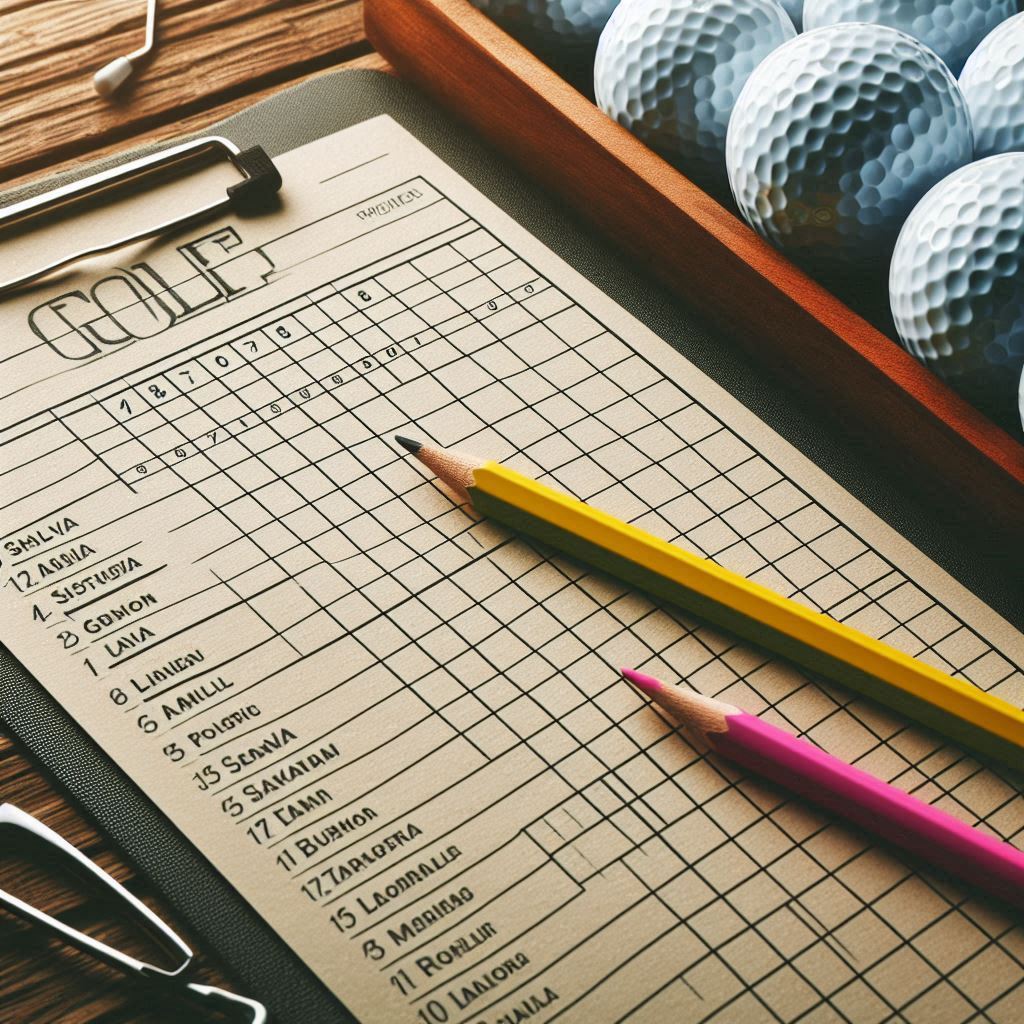Golf is a sport that demands precision, skill, and strategic thinking. Whether you’re a beginner or an experienced player, there’s always room for improvement. This comprehensive guide will provide you with the best tips and techniques to improve your golf game and lower your handicap. By focusing on key areas such as golf swing tips, putting tips, golf practice drills, and overall golf strategy, you’ll be well on your way to achieving your golfing goals.
Improve Your Golf Game
Improving your golf game is a continuous process that involves refining your skills, enhancing your strategies, and consistently practicing. Here are some essential tips to get you started:
1. Understand Your Strengths and Weaknesses

Identifying the areas of your game that need the most work is crucial for targeted improvement. Begin by honestly assessing your performance in various aspects of the game, such as driving, iron play, short game, and putting. Utilize tools like golf simulators, which can provide detailed analytics on your swing mechanics, ball trajectory, and overall consistency.
These advanced technologies offer a comprehensive breakdown of your game, highlighting specific weaknesses. Additionally, seeking feedback from a golf coach can be immensely beneficial. A professional coach can offer expert insights, observe your technique in real-time, and suggest personalized drills and adjustments. By combining technology with professional guidance, you can gain a clearer understanding of where you need to focus your efforts, leading to more effective and efficient practice sessions.
2. Consistent Practice

Regular practice is key to improving your golf game and lowering your handicap. To maximize the benefits of your practice sessions, it’s essential to dedicate specific times each week to work on different aspects of your game. This structured approach ensures that you develop a well-rounded skill set. For example, you might allocate certain days to focus on driving, where you concentrate on power and accuracy off the tee, while other sessions might be dedicated to iron play, where you work on precision and control.
Additionally, set aside time to practice your short game, including chipping and bunker shots, as well as dedicated putting practice to refine your touch and accuracy on the greens. By consistently practicing each aspect of your game, you’ll build muscle memory, improve your technique, and develop greater confidence in your abilities.
3. Use Technology

Modern technology, such as golf apps and GPS devices, plays a crucial role in tracking your progress and providing detailed feedback on your performance. These tools offer real-time data and analytics that can reveal insights into every aspect of your game, from swing speed and ball trajectory to shot accuracy and course management. Golf apps often include features such as digital scorecards, swing analysis, and personalized coaching tips, which can help you identify patterns and areas needing improvement.
GPS devices provide precise distance measurements and course layouts, enabling you to make more informed decisions on the course. By leveraging these technologies, you can monitor your progress over time, set specific goals, and adjust your practice routines based on objective data, ultimately leading to a more strategic and effective approach to improving your golf game.
4. Physical Fitness

Golf is a physical sport that demands not only skill but also a high level of physical fitness. To enhance your performance on the course, it is essential to maintain a comprehensive fitness routine that focuses on building strength, flexibility, and endurance. Strength training exercises, such as those targeting the core, legs, and upper body, can help you generate more power in your swings, while improving your balance and stability. Flexibility exercises, including stretching and yoga, are crucial for maintaining a full range of motion, which is vital for achieving a smooth and efficient swing.
Additionally, cardiovascular workouts like running, cycling, or swimming can boost your stamina, ensuring you stay energized and focused throughout an entire round. By integrating these elements into your fitness regimen, you’ll not only enhance your physical capabilities but also reduce the risk of injury, enabling you to perform at your best consistently.
Golf Tips
Here are some practical golf tips that can help you elevate your game. Implementing these strategies can lead to noticeable improvements in your performance on the course. Whether you’re looking to refine your swing technique, enhance your short game, or improve your course management skills, these tips offer valuable insights to help you achieve your golfing goals:
1. Focus on Your Grip

Your grip is fundamental to your swing and serves as the primary connection between you and the club. Ensuring that your hands are positioned correctly is crucial for control and power. The proper grip involves positioning the club diagonally across the fingers of your lead hand, which promotes a more natural wrist hinge and better control of the clubface. Your trail hand should then wrap comfortably around the club, with both hands working together to form a unified grip.
A correct grip allows for greater precision and consistency in your swing, as it helps maintain the proper clubface angle throughout the swing. This reduces the chances of errant shots caused by an open or closed clubface at impact. Regularly checking and adjusting your grip during practice can help reinforce good habits and lead to improved performance on the course.
2. Perfect Your Posture

A good posture sets the foundation for a great swing, serving as the cornerstone of your entire golf technique. Ensuring that you start with the correct posture enables you to execute a more powerful and consistent swing. To achieve this, keep your back straight to maintain proper alignment and reduce the risk of injury. Your knees should be slightly bent, providing a stable base and allowing for better mobility and balance throughout the swing.
It’s also important to distribute your weight evenly between your feet, which helps maintain balance and control. By setting up with a solid, athletic posture, you’ll be able to make a more efficient and effective turn during your backswing and downswing, leading to more accurate and powerful shots. Regularly practicing and checking your posture will help ingrain these habits, ensuring that you maintain the proper setup every time you address the ball.
3. Control Your Tempo

Maintaining a smooth, consistent tempo throughout your swing is essential for achieving accuracy and control in your golf game. A well-paced swing allows you to harness your body’s power efficiently and ensures better timing, which is critical for solid contact with the ball. Avoid the common mistake of rushing your backswing or downswing, as this can lead to poor mechanics, loss of balance, and inconsistent ball striking.
Instead, focus on a rhythmic, deliberate motion where each phase of the swing flows seamlessly into the next. By practicing with an emphasis on tempo, you can develop a more reliable and repeatable swing, leading to improved performance and lower scores on the course. Utilizing drills and metronomes designed to help with swing tempo can further reinforce this crucial aspect of your technique.
4. Visualize Your Shot

Before you take your shot, it’s essential to visualize the ball’s trajectory and where you want it to land. This mental preparation can significantly improve your accuracy by providing a clear target and helping you focus on executing the shot. Visualization involves imagining the ball’s path from the moment it leaves the clubface to where it will land on the fairway or green, taking into account any obstacles, wind conditions, and the slope of the terrain.
By picturing the ideal flight and outcome, you create a mental blueprint that guides your physical movements. This process helps to calm your mind, reduce anxiety, and increase confidence, as you have a precise plan for your swing. Incorporating visualization into your pre-shot routine can lead to more consistent and accurate shots, as it aligns your mental and physical efforts towards a common goal.
Golf Techniques
Mastering various golf techniques can significantly enhance your performance on the course. Here are some essential techniques to focus on, including driving accuracy, iron play, and putting proficiency. By honing these skills, you can improve your overall game and lower your scores consistently:
1. The Full Swing

A powerful and accurate full swing is crucial for achieving maximum distance and precision in your golf game. To develop this, it’s essential to focus on each phase of the swing: the backswing, downswing, and follow-through. During the backswing, ensure you make a smooth and controlled movement, turning your shoulders and hips away from the target while maintaining a steady head position. This helps build potential energy and sets the stage for a powerful downswing.
As you transition into the downswing, initiate the motion with your lower body, allowing your hips to lead and your hands to follow, creating a whip-like effect that increases clubhead speed. Finally, a complete and balanced follow-through is vital, as it ensures that you maintain the proper swing path and clubface alignment through impact. By paying attention to these key components, you can generate more power and accuracy, leading to longer, straighter shots and ultimately improving your overall performance on the course. Regular practice and fine-tuning of each element will help solidify a more effective and reliable full swing.
2. Chipping

Chipping is vital for close-range shots and can significantly impact your overall score by improving your ability to get up and down from around the green. To execute effective chips, use a controlled, compact swing that prioritizes precision over power. Position the ball slightly back in your stance to encourage a descending strike, and maintain a firm wrist position throughout the shot to ensure consistency. Focus on getting the ball to land softly on the green and roll towards the hole, rather than trying to carry it all the way.
This involves selecting the right club, typically a wedge, and making a smooth, abbreviated motion that emphasizes control. By practicing a variety of chipping scenarios, such as different lies and distances, you can develop a feel for how the ball reacts and improve your ability to place it accurately on the green. Mastering the chip shot will enhance your short game, reduce the number of strokes taken around the green, and ultimately contribute to lowering your handicap.
3. Bunker Play

Bunker shots can be challenging but mastering them is essential for improving your short game and overall performance. When faced with a bunker shot, start by opening your clubface, which increases the loft and helps the ball get out of the sand more easily. Position your feet slightly wider than shoulder-width apart for stability, and dig them into the sand to create a solid base. Aim to hit the sand approximately two inches behind the ball, using the bounce of the club to slide under and lift the ball.
This technique helps the clubface to enter the sand first, creating a cushion of sand that propels the ball upward and out of the bunker. Maintain a smooth, controlled swing with a full follow-through to ensure the ball carries the necessary distance to land softly on the green. By practicing these specific techniques, you can gain confidence and consistency in bunker play, turning a potentially daunting shot into a manageable one. Regular practice in different bunker conditions will enhance your ability to handle various sand textures and lies, ultimately improving your overall game.
4. Putting

Putting requires precision and control, as it is one of the most critical aspects of golf that can significantly affect your score. To improve your putting technique, practice putts from various distances, ranging from short tap-ins to longer, challenging putts. This variation helps you develop a feel for different lengths and the confidence to handle any putting situation you encounter on the course. Focus on maintaining a steady, smooth stroke by keeping your wrists firm and using a pendulum-like motion with your shoulders.
This consistency in your stroke will help you control the speed and direction of the ball more effectively. Additionally, pay attention to your alignment and ensure your eyes are directly over the ball to enhance accuracy. Incorporate drills that emphasize distance control, such as the ladder drill, and practice on different types of greens to become adept at reading breaks and slopes. By dedicating time to refining your putting skills, you’ll lower the number of putts per round, ultimately reducing your overall score and improving your performance.
Lower Handicap


Lowering your handicap is a primary goal for many golfers striving to improve their game. Here are some strategies to help you achieve this, including focusing on consistency, refining your short game, and practicing with purpose. By implementing these strategies and dedicating yourself to continuous improvement, you can work towards achieving your target handicap and becoming a more accomplished golfer:
1. Track Your Progress


Keep a detailed record of your scores and track various statistics from each round, such as fairways hit, greens in regulation, number of putts, and sand saves. Analyzing these records allows you to identify patterns and trends in your performance, helping you to pinpoint specific areas that need improvement. For instance, if you notice that you’re consistently missing fairways with your driver, you might need to work on your driving accuracy. Alternatively, if you’re taking too many putts, focusing on your putting technique could be beneficial.
By regularly reviewing your performance data, you can set more precise practice goals, create targeted training sessions, and monitor your progress over time. This analytical approach not only provides clear insights into your strengths and weaknesses but also helps you make informed decisions about your practice and strategy, ultimately leading to a more effective improvement plan and better overall performance on the course.
2. Play Regularly


The more you play, the better you’ll get. Regularly participating in rounds of golf not only hones your skills but also helps you become more comfortable and confident on the course. Each round provides an opportunity to apply what you’ve practiced, learn from your mistakes, and experience different playing conditions and course layouts. This consistent exposure helps you develop a more intuitive understanding of the game, from reading greens and managing course strategy to handling pressure situations.
Playing regularly also allows you to build muscle memory, making your swing and other techniques more automatic and reliable. Moreover, frequent play fosters mental toughness and resilience, as you become accustomed to both the physical and psychological demands of the sport. By integrating regular rounds into your routine, you’ll steadily improve your game, lower your scores, and gain the confidence needed to tackle any golfing challenge.
3. Take Lessons


Professional golf lessons can provide personalized feedback and guidance tailored specifically to your individual needs and skill level. A qualified golf instructor can analyze your swing mechanics, identify any flaws or inefficiencies, and offer targeted drills and exercises to address those issues. By investing in lessons, you’ll benefit from expert insights that can accelerate your learning process and help you avoid common mistakes that could hinder your progress. Lessons can be customized to focus on particular areas where you need the most improvement, whether it’s driving,
iron play, short game, or putting. Additionally, professional guidance can provide you with a deeper understanding of the game’s fundamentals, course management strategies, and mental approaches to enhance your overall performance. With a structured learning plan and regular feedback from a coach, you can fast-track your improvement, gain confidence, and achieve your golfing goals more efficiently.
4. Set Realistic Goals


Setting achievable goals for each round or practice session is crucial for maintaining motivation and ensuring continuous improvement. These goals provide a clear direction and purpose for your practice, helping you stay focused on specific areas that need attention. For example, you might set a goal to hit a certain number of fairways, improve your putting accuracy, or reduce the number of strokes in your short game. By breaking down your overall improvement into smaller, manageable objectives, you can measure your progress more effectively and celebrate incremental successes.
This approach not only keeps you engaged and motivated but also helps you build confidence as you achieve each goal. Moreover, setting realistic targets prevents frustration and burnout, ensuring that your practice sessions are productive and enjoyable. Regularly reviewing and adjusting your goals based on your progress ensures that you remain challenged and committed to your development as a golfer.
Golf Swing Tips
Your swing is the cornerstone of your golf game, influencing the accuracy and distance of your shots. To refine your swing, focus on proper grip, stance, and posture to ensure a solid foundation. Additionally, practice tempo and rhythm to achieve a smooth and controlled motion through your swing:
1. Use Your Body, Not Just Your Arms


A powerful swing comes from using your entire body, not just your arms. Engaging your core and legs is essential to generate more power and control in your swing. Your legs provide a stable base and drive the initial movement, while your core facilitates the rotation and transfer of energy through your body to the club. As you begin your backswing, rotate your shoulders and hips together, creating a coil that stores potential energy. During the downswing, initiate the motion with your hips, allowing your core muscles to lead and your upper body to follow, ensuring a smooth and coordinated action.
This sequence maximizes the force and speed of your swing, transferring energy efficiently to the ball. Additionally, focusing on a full-body swing helps maintain balance and consistency, reducing the risk of injuries caused by over-reliance on arm strength. By practicing techniques that involve your whole body, you can develop a more powerful and controlled swing, leading to longer drives and more accurate shots.
2. Maintain a Strong Stance


A stable stance is crucial for a successful golf swing, as it provides the foundation needed for balance and power. To achieve this, start by positioning your feet shoulder-width apart, which offers a solid base and allows for proper weight transfer during the swing. Distribute your weight evenly between both feet, ensuring that you feel balanced and grounded. This even distribution helps maintain stability throughout the swing, allowing for a smooth and controlled motion. During the backswing, shift your weight slightly to your back foot while keeping your body centered.
As you transition into the downswing, shift your weight forward onto your front foot, driving through the ball with power and precision. Keeping a stable stance not only enhances your balance but also improves your swing mechanics, leading to more consistent and accurate shots. Regularly practicing your stance and weight distribution will help ingrain these fundamentals, making them a natural part of your setup routine and ultimately improving your overall performance on the course.
3. Follow Through


A proper follow-through is essential for a complete and effective golf swing, as it ensures that you maintain the correct form and maximize power through impact. After striking the ball, continue to rotate your body, allowing your hips and shoulders to turn fully towards the target. This rotation should be smooth and controlled, with your weight shifting onto your front foot. Finish the swing with your chest facing your target, which indicates that you have completed a full body turn and transferred your energy efficiently.
Your arms should extend naturally, and the club should finish high, with the shaft pointing down your target line. A proper follow-through not only enhances the distance and accuracy of your shots but also helps to prevent injuries by ensuring that your body moves fluidly and without undue strain. Practicing your follow-through can reinforce good swing habits and contribute to a more consistent and powerful golf game.
4. Practice Swing Drills


Incorporating swing drills into your practice routine is an effective way to refine your mechanics and enhance your overall performance on the golf course. Drills such as the “pause at the top” help you develop better control and timing by encouraging you to briefly stop your backswing at its peak, ensuring a smoother transition into the downswing. This pause helps you focus on proper alignment and balance, which are crucial for consistent ball striking.
Another beneficial drill is the “one-handed swing,” which involves practicing your swing with just one hand, either left or right. This drill strengthens your dominant arm, improves coordination, and highlights any imbalances or weaknesses in your swing technique. By regularly integrating these and other targeted drills into your practice sessions, you can address specific areas of your swing that need improvement, build muscle memory, and develop a more fluid and powerful swing. These focused exercises not only make your practice time more productive but also translate into more effective and consistent performance on the course.
Putting Tips
Improving your putting skills can significantly lower your scores by reducing the number of putts per round. To become a better putter, focus on developing a consistent putting stroke and maintaining proper alignment. Practice distance control and read greens carefully to judge speed and break accurately, ultimately improving your ability to sink putts more consistently:
1. Focus on Alignment



Proper alignment is key to successful putting, as it sets the foundation for accuracy and consistency on the greens. To ensure your alignment is correct, start by positioning your eyes directly over the ball. This perspective helps you better judge the line and distance, making it easier to aim accurately. Next, align your putter face square to your target line, meaning the face should be perpendicular to the path you want the ball to travel.
This ensures that the ball will roll straight towards your intended target. Additionally, your feet, hips, and shoulders should be parallel to the target line to maintain a consistent stroke path. By focusing on these alignment principles, you create a solid setup that promotes a more reliable and repeatable putting stroke. Regularly practicing proper alignment will help you develop the habit of setting up correctly every time, leading to more confident and accurate putts on the course.
2. Develop a Consistent Stroke


Consistency is crucial in putting because it directly affects your accuracy and ability to sink more putts. To achieve this, focus on maintaining a steady, rhythmic stroke. A consistent tempo ensures that each putt is delivered with the same speed and control, which is essential for judging distances accurately. Start by developing a smooth, pendulum-like motion where your shoulders, not your wrists, drive the stroke. This helps to minimize unnecessary movements and maintain a straight path.
Practice drills that emphasize rhythm, such as counting out a beat during your backswing and follow-through, can help reinforce this steady motion. Additionally, ensure that your grip pressure remains constant throughout the stroke to avoid any jerky movements. By regularly practicing with a focus on consistency, you will develop muscle memory and a reliable putting routine, leading to improved performance on the greens and lower scores overall.
3. Read the Green


Learning to read the green and understand its slopes and breaks is essential for accurate putting. This skill allows you to judge the speed and direction of your putts more effectively. Start by examining the green from different angles to identify any slopes or contours that might affect the ball’s path. Pay attention to the grain of the grass, which can influence the ball’s speed and direction depending on whether you’re putting with or against it.
Observe the general lay of the land and note any subtle undulations that could cause the ball to break. During your practice rounds, take time to roll a few extra putts from various positions to get a feel for how the ball reacts on different parts of the green. Understanding these elements will help you better predict the ball’s movement, allowing you to adjust your aim and stroke accordingly. By incorporating green reading into your routine, you’ll develop a keener sense of judgment for both speed and direction, leading to more successful putts and lower scores.
4. Practice Short Putts


Short putts are often the most challenging and can significantlymaintai impact your score, as missing these close-range opportunities can be frustrating and costly. To improve your proficiency with short putts, dedicate ample practice time to putts within six feet. This practice helps build confidence, allowing you to approach each short putt with a positive mindset and reduced anxiety. Focus on maintaining a steady, consistent stroke and proper alignment to ensure the ball travels on your intended line.
Use drills such as the clock drill, where you place balls in a circle around the hole and practice making each putt, to simulate pressure situations and improve your consistency. By honing your skills on short putts, you can reduce the number of missed opportunities during your rounds, ultimately leading to lower scores and a more reliable short game. Regular practice will make these crucial putts feel automatic, enhancing your overall putting performance.
Golf Practice Drills
Effective practice drills play a crucial role in refining your skills and enhancing your overall performance on the golf course. Incorporating specific drills into your practice routine can target key areas of your game, such as swing mechanics, short game proficiency, and putting accuracy. By dedicating time to these drills regularly, you can strengthen your weaknesses, build confidence, and ultimately see improvements in your scores during rounds:
1. The Alignment Drill


Using alignment sticks is a highly effective drill to ensure that both your body and clubface are correctly aligned, which is crucial for improving accuracy and consistency in your golf game. To perform this drill, place one alignment stick on the ground pointing towards your target, and another parallel to it to represent the line of your feet, hips, and shoulders. Position your clubface square to the target line stick, and make sure your body lines up with the parallel stick.
This setup helps you create a visual reference, reinforcing the proper alignment of your entire setup. Practicing with alignment sticks regularly will train your body to adopt the correct stance and aim instinctively. It also helps you develop muscle memory for a consistent address position, leading to more accurate and reliable shots. Over time, this drill can significantly enhance your ball-striking ability, as it ensures that you are aligned correctly for every shot, whether driving off the tee or hitting approach shots to the green. Incorporating alignment sticks into your practice routine can ultimately lead to a more precise and consistent golf game.
2. The Lag Putting Drill


Focusing on lag putting by practicing long-distance putts is essential for developing better distance control and reducing the occurrence of three-putts. Lag putting involves hitting putts from significant distances with the goal of getting the ball close to the hole, ideally within a manageable range for a tap-in. To improve this skill, spend time practicing putts from 20, 30, or even 40 feet away. Concentrate on controlling the speed and pace of your stroke, rather than just aiming for the hole.
This practice helps you develop a feel for the appropriate force needed to cover various distances on the green. By honing your ability to judge and execute long-distance putts, you’ll leave yourself shorter, more makeable second putts, thus reducing the likelihood of three-putting. Regularly practicing lag putting enhances your overall confidence in managing the greens, leading to fewer strokes and better scores during your rounds.
3. The Chipping Ladder Drill


Setting up targets at different distances and practicing chipping to each one is a highly effective drill for enhancing your touch and control around the green. By placing targets such as tees, hula hoops, or small flags at various distances, you can simulate real-game scenarios that require precise chip shots. Focus on using a controlled, compact swing to land the ball accurately at each target.
This exercise helps you develop a better feel for the amount of force needed to achieve the desired distance and trajectory. Varying the distances of your targets encourages you to adjust your technique and club selection accordingly, which is crucial for adapting to different situations on the course. Regular practice with this drill will improve your ability to execute delicate shots with confidence, ultimately leading to more up-and-downs and lower scores. By honing your chipping skills through targeted practice, you’ll become more proficient at managing short-game challenges and enhancing your overall performance.
4. The Swing Plane Drill


Using a swing plane trainer or a weighted club is an excellent drill to ensure your swing stays on the correct path, which is vital for developing a more consistent and powerful swing. A swing plane trainer guides your club along the proper trajectory, helping you understand the ideal swing path and correcting any deviations. Practicing with this tool reinforces muscle memory, so your swing becomes more automatic and reliable. Similarly, a weighted club increases strength and stability in your swing, making it easier to maintain the correct path under normal conditions.
The added weight helps you feel the motion more clearly and build the necessary muscles for a powerful swing. Incorporating these tools into your practice routine allows you to focus on maintaining a proper swing plane, reducing the chances of slicing or hooking the ball. Over time, this leads to more consistent ball striking, increased accuracy, and greater distance. By regularly practicing with a swing plane trainer or weighted club, you can achieve a more effective and dependable golf swing.
Golf Lessons
Investing in golf lessons can offer significant benefits by providing personalized feedback and guidance tailored to your individual needs and goals. To make the most out of your lessons, approach each session with a positive attitude and a willingness to learn and improve. Communicate openly with your instructor about your objectives and areas of focus, and be proactive in implementing their advice and recommendations into your practice routine to maximize your progress:
1. Choose the Right Instructor


Finding a qualified golf instructor with a solid track record is essential for improving your game. Start by seeking personal recommendations from friends, family, or fellow golfers who have had positive experiences with their instructors. These firsthand accounts can provide valuable insights into the instructor’s teaching style, effectiveness, and personality. Additionally, reading online reviews and testimonials can offer further information about the instructor’s reputation and success with other students. Look for instructors who have relevant certifications, significant teaching experience, and a proven ability to help golfers improve.
It’s also important to consider whether the instructor’s teaching style aligns with your learning preferences. By taking the time to research and find a well-qualified instructor, you ensure that your lessons will be productive, enjoyable, and tailored to your specific needs, ultimately leading to better performance on the course. Investing in the right instructor can make a significant difference in your golf journey, helping you to achieve your goals more efficiently and effectively.
2. Set Clear Objectives


Before starting your golf lessons, it’s important to outline your specific goals and what you want to achieve. Having clear objectives helps your instructor understand your aspirations and tailor the lessons to meet your needs. Whether you aim to improve your swing mechanics, enhance your short game, lower your handicap, or prepare for a tournament, clearly communicating these goals allows the instructor to develop a personalized training plan. Detailing your strengths and weaknesses also gives the instructor insight into areas that require focused attention.
By setting specific, measurable goals, you and your instructor can track progress more effectively and make necessary adjustments along the way. This targeted approach not only maximizes the efficiency of each lesson but also keeps you motivated and engaged. Ultimately, having well-defined goals ensures that your lessons are structured, purposeful, and aligned with your long-term development in the sport.
3. Be Open to Feedback


Constructive criticism plays a crucial role in the journey of improvement in golf. It’s essential to remain open to feedback from instructors, fellow golfers, or even video analysis. Embrace constructive criticism as an opportunity to identify areas for growth and refinement in your technique. By being receptive to feedback and willing to make adjustments, you can address weaknesses and fine-tune your skills more effectively.
Remember that feedback is an invaluable tool for progress, helping you develop a deeper understanding of your game and enabling you to make informed decisions about your training. Cultivating a mindset that values constructive criticism fosters continuous improvement and ultimately leads to better performance on the course.
4. Practice Between Lessons


Practice is key to mastering the techniques and drills you learn in your golf lessons. Consistent practice not only reinforces what you’ve learned but also accelerates your progress on the course. Make time to integrate the techniques and drills into your regular practice sessions, focusing on repetition and refinement. Whether it’s working on your swing mechanics, chipping, or putting, dedicate specific practice time to each aspect of your game. Additionally,
incorporate feedback from your instructor into your practice routine, focusing on areas that need improvement. By committing to regular and focused practice, you’ll develop muscle memory, increase confidence, and see noticeable improvements in your performance over time. Remember that consistent practice is the key to translating lessons into tangible results on the course.
Golf Strategy
Developing a solid golf strategy is essential for making smarter decisions on the course and ultimately lowering your scores. Consider factors such as course layout, weather conditions, and your own strengths and weaknesses when formulating your strategy for each round. By implementing strategic tips such as course management, shot selection, and risk assessment, you can navigate the course more effectively and improve your overall performance:
1. Course Management


Understanding the layout of the golf course is essential for strategic play and maximizing your scoring potential. Take the time to study the course layout, noting the location of hazards, bunkers, and doglegs. By familiarizing yourself with the terrain, you can plan your shots more effectively, playing to your strengths and avoiding high-risk areas.
Consider factors such as wind direction, slope, and pin placement when selecting your clubs and deciding on your approach. Aim to play conservative shots that minimize the chances of landing in trouble while still positioning yourself for a favorable next shot. By adopting a strategic mindset and making informed decisions based on the course layout, you can optimize your performance and achieve lower scores on the course.
2. Play to Your Strengths


Focusing on using clubs and shots that you’re most comfortable with is crucial for playing golf with confidence and consistency. Identify the clubs and shots that suit your strengths and preferences and incorporate them into your game plan. Whether it’s relying on your favorite iron for approach shots or opting for a reliable chip shot around the green, playing to your comfort zone helps you maintain control and execute shots more effectively.
By sticking to familiar clubs and shots, you can minimize the risk of mistakes and feel more confident in your ability to execute each shot with precision. Trusting your instincts and playing within your comfort level ultimately leads to more consistent performance and better scores on the course.
3. Stay Mentally Tough


Golf is a sport that requires mental strength and focus as much as physical skill. To excel on the course, it’s essential to develop a pre-shot routine that helps you stay composed and focused, especially when facing pressure situations. Your pre-shot routine should be personalized to suit your preferences and needs, but typically involves a series of steps that you follow before every shot.
This routine could include visualizing the intended shot, taking a few deep breaths to relax, aligning your body and clubface, and committing fully to your chosen target. By establishing a consistent pre-shot routine, you create a sense of familiarity and control, which can help alleviate nerves and maintain concentration during critical moments. Over time, this mental discipline becomes second nature, allowing you to perform at your best even under pressure.
4. Adapt to Conditions


In golf, being prepared to adapt your strategy based on weather conditions and the state of the course is crucial for success. Weather factors such as wind direction, rain, or extreme temperatures can significantly impact how the ball travels and how the course plays. Similarly, the condition of the course, such as wet fairways or fast greens, can affect your club selection and shot strategy.
Flexibility is key to handling these variables effectively, allowing you to adjust your game plan accordingly. This might involve altering your shot trajectory, club choice, or even your approach to specific holes based on the prevailing conditions. By remaining adaptable and open to change, you can navigate various scenarios with confidence and maximize your chances of success on the course.
Golf Improvement
Continual improvement in golf demands dedication, consistent practice, and a mindset of continuous learning. Embrace opportunities to refine your skills and knowledge through regular practice sessions, lessons, and studying the game. Stay open to feedback, analyze your performance, and set achievable goals to track your progress and maintain motivation on your journey to becoming a better golfer:
1. Set Regular Goals


Setting both short-term and long-term goals for your golf game is essential for maintaining motivation and charting your progress over time. Short-term goals allow you to focus on specific aspects of your game that you want to improve in the near future, such as mastering a new technique or reducing your number of putts per round. These goals provide immediate targets to work towards, keeping you motivated and engaged in your practice sessions.
Long-term goals, on the other hand, provide a broader vision for your overall development in the sport, such as lowering your handicap or competing in tournaments. By setting long-term goals, you create a roadmap for your golfing journey, giving you a clear sense of direction and purpose. Whether it’s achieving a specific handicap milestone or mastering a particular aspect of your game, having both short-term and long-term goals ensures that you’re constantly striving for improvement and staying committed to your development as a golfer.
2. Stay Informed


Staying updated with the latest golf techniques and trends is crucial for continuously improving your game. Keep yourself informed by reading books, watching instructional videos, and following professional players to learn new strategies and methods. By staying ahead of the game, you can adapt to changes in equipment, course conditions, and playing styles more effectively.
Additionally, learning from the experiences and insights of seasoned professionals can provide valuable tips and insights to enhance your own skills. Embrace a mindset of continuous learning and exploration, seeking out new information and perspectives to refine your techniques and elevate your performance on the course. By staying abreast of the latest developments in the world of golf, you can remain competitive and ensure that your game continues to evolve and progress over time.
3. Play with Better Golfers


Playing with golfers who are better than you can be an invaluable opportunity for growth and improvement. Surrounding yourself with more skilled players exposes you to different playing styles, strategies, and techniques that you can learn from and incorporate into your own game. Additionally, observing how better players approach challenges and handle pressure situations can inspire you to elevate your performance and strive for higher levels of success.
Playing alongside more experienced golfers also provides a benchmark for your progress, motivating you to continuously refine your skills and strive for excellence. Embrace the opportunity to learn from those who excel in the sport, and use their expertise to push yourself to new heights on the course.
4. Enjoy the Game


It’s important to remember to enjoy the process of improving your golf game. While striving for improvement is essential, maintaining a positive attitude throughout your journey will keep you motivated and make the experience more rewarding. Embrace the challenges and setbacks as opportunities for growth, and celebrate your progress along the way.
Find joy in the small victories, whether it’s mastering a new technique, achieving a personal best score, or simply spending time on the course with friends and loved ones. Cultivating a positive mindset not only enhances your overall experience but also fosters resilience and determination in the face of adversity. By approaching your golf journey with enthusiasm and optimism, you’ll not only become a better player but also derive greater fulfillment from the game itself.
By incorporating these tips and techniques into your routine, you’ll be well on your way to improving your golf game and lowering your handicap. Whether you’re focusing on your swing, putting, or overall strategy, consistent practice and a dedication to learning will yield significant results. Happy golfing!
FAQS (Frequently Asked Questions)
FAQ 1: How can I improve my golf game quickly?
Answer: Improving your golf game quickly involves a combination of focused practice, taking professional lessons, and using technology to analyze your performance. Prioritize areas where you are weakest, practice regularly, and incorporate drills into your routine. Consistent play and feedback from a coach can also expedite your improvement.
FAQ 2: What are some essential golf tips for beginners?
Answer: For beginners, it’s important to focus on the basics: grip, posture, and swing. Ensure your grip is neither too tight nor too loose, maintain a proper stance with knees slightly bent, and practice a smooth, controlled swing. Additionally, learn to read the course and develop a consistent pre-shot routine.
FAQ 3: How do I lower my golf handicap?
Answer: Lowering your handicap requires a combination of improving your technique, practicing consistently, and playing strategically. Track your scores to identify areas for improvement, focus on short game and putting, and consider taking lessons to get personalized advice. Regular play and setting specific goals for each round will also help.
FAQ 4: What are the key elements of a good golf swing?
Answer: A good golf swing involves a proper grip, balanced posture, and a smooth tempo. Key elements include rotating your shoulders during the backswing, shifting your weight correctly, and following through with a full body rotation. Practicing with drills that focus on these elements can enhance your swing mechanics.
FAQ 5: How important is putting in golf?
Answer: Putting is extremely important in golf as it can significantly impact your score. Good putting can reduce the number of strokes per round, especially from short distances. Developing a consistent putting stroke, learning to read greens, and practicing regularly are crucial for improving your overall game.
FAQ 6: What are effective golf practice drills?
Answer: Effective golf practice drills include the alignment drill, lag putting drill, chipping ladder drill, and swing plane drill. These drills help improve accuracy, distance control, touch around the greens, and swing mechanics. Incorporating a variety of drills into your practice routine can address different aspects of your game.
FAQ 7: Should I take golf lessons, and how often?
Answer: Yes, taking golf lessons can be very beneficial, especially for identifying and correcting specific weaknesses. The frequency of lessons depends on your goals and availability, but starting with one lesson every couple of weeks can provide enough time to practice and integrate what you learn.
FAQ 8: What strategies can help me play better golf?
Answer: Effective golf strategies include course management, playing to your strengths, staying mentally focused, and adapting to changing conditions. Plan your shots based on your skill level, avoid high-risk shots, maintain a calm and focused mindset, and be flexible with your strategy based on weather and course conditions.
FAQ 9: How can I improve my mental game in golf?
Answer: Improving your mental game involves developing a pre-shot routine, staying focused, and managing stress. Practice visualization techniques, maintain a positive attitude, and focus on the process rather than the outcome. Learning to stay calm and composed under pressure is key to consistent performance.
FAQ 10: What are the benefits of playing golf regularly?
Answer: Playing golf regularly helps improve your skills, enhances physical fitness, and provides mental relaxation. Regular play allows you to practice different aspects of your game, build muscle memory, and develop better course management. Additionally, golf can be a social activity that promotes overall well-being.
















